Key Facts:
- The East Coast is comprised of several habitats which are suitable for snakes.
- The nonvenomous Carolina water snake can be found on the salt marshes of the Outer Banks and the neighboring mainland.
- The short-fanged eastern coral snake prefers sandy, open areas with sparse vegetation.

Snakes may be among the most widespread reptile species in the world, having over 3,000 different species spread across the globe! It means that anywhere you live (except Antarctica, Greenland, Iceland, Ireland, and New Zealand), you’ll likely encounter a snake or two. And if you are living in the suburbs or less populated rural places, then the chances of encountering snakes are even higher.
If you are living on the East Coast, there is a huge chance that you’ve seen snakes, particularly if you settle around the southeastern states of the United States, such as Florida and Georgia. The East Coast is replete with various shapes of nature, and this diversity also caters to a wide range of habitats for different types of snakes. While many snake species in North America are distributed across 50 states, some of them are exclusively found on the East Coast. This article will list the snakes that only live on the East Coast and more.
What Comprises the East Coast?
The North Atlantic Ocean and the Eastern United States meet along the United States East Coast, commonly referred to as the Eastern Seaboard or Atlantic Coast. The region consists of the Atlantic Ocean-facing coastal states and territory east of the Appalachian Mountains, including Florida, Georgia, North and South Carolina, Massachusetts, Rhode Island, Connecticut, Maine, New Hampshire, New York, New Jersey, Delaware, Maryland, and Virginia.
15 Snakes That Only Live On The East Coast
1. Carolina Pygmy Rattlesnake
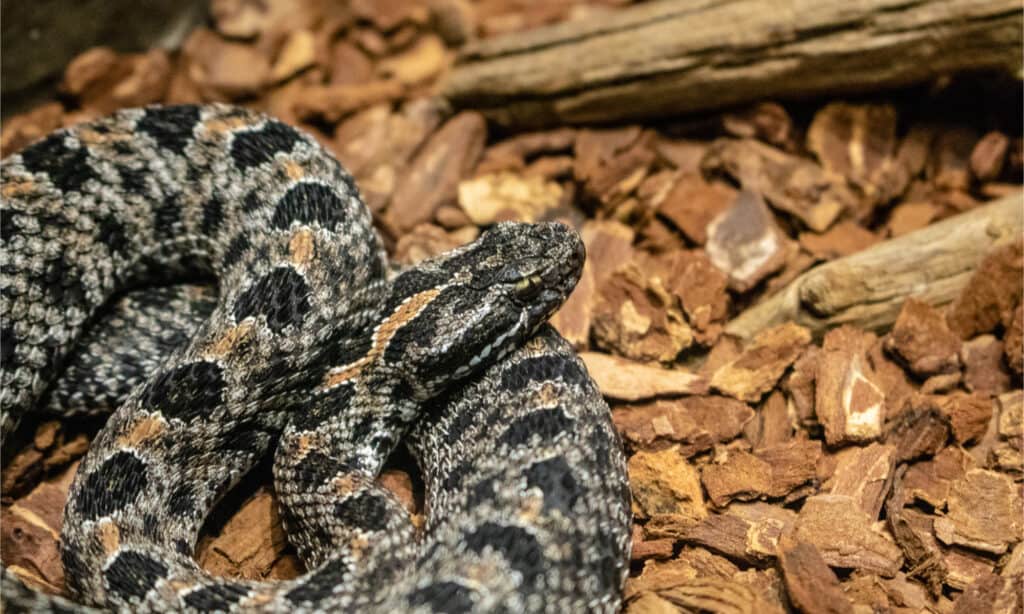
©Suzanna Ruby/Shutterstock.com
The Coastal Plains region of South Carolina is home to pygmy rattlesnakes. Sandhills, floodplains, and mixed woods are where you’ll commonly find these snakes. Pygmy rattlesnakes can be found between March and October near freshwater bodies of water, such as marshes, swamps, ponds, and streams. During these months, pygmy rattlesnakes are busy as they search for tiny creatures, including frogs, lizards, and rodents. Pygmy rattlesnakes are much smaller than the other rattlesnakes in South Carolina, reaching lengths of only 14 to 30 inches.
2. Carolina Water Snake

Northern watersnakes are the most common of all watersnake species.
©Patrick Coin / CC BY-SA 2.5 – License
The northern Coastal Plain, Piedmont, and mountains of North Carolina are home to a range of aquatic habitats where northern water snakes can be found. They are rather large, heavy-bodied water snakes, and the ones found in the salt marshes of the Outer Banks and the neighboring mainland are a different subspecies known as the “Carolina water snake.” Carolina water snakes are significantly darker than those from inland locales. The northern water snake is not venomous, but because of its superficial appearance, it is frequently mistaken for the venomous cottonmouth and copperhead.
3. Eastern Coral Snake
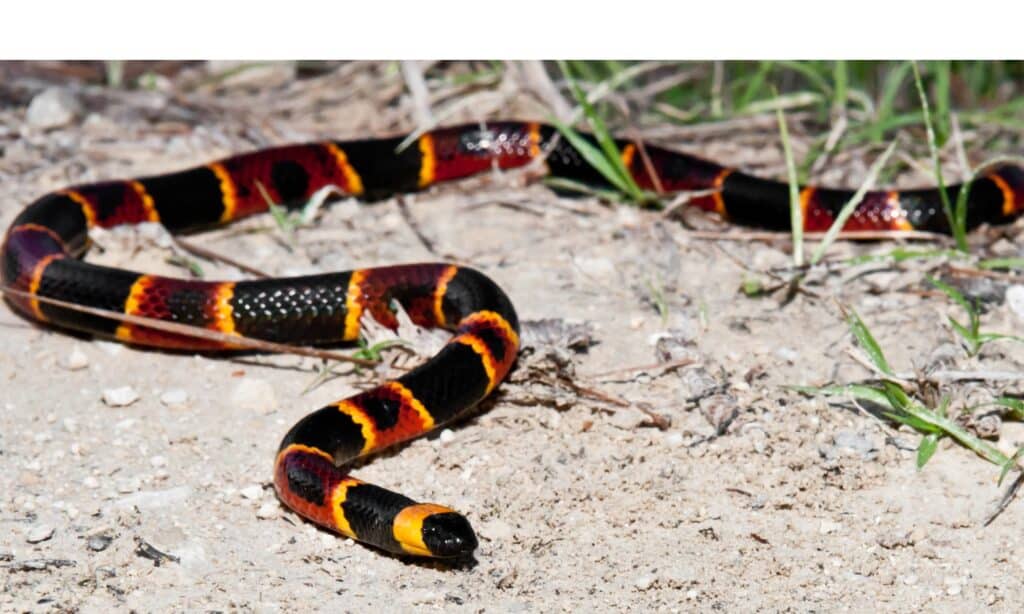
As the only North American elapid, coral snakes are sometimes called “North American cobras.”
©iStock.com/JasonOndreicka
Only the southeastern region of the United States is home to the eastern coral snake. It favors habitats with hammocks, flat woods with slash pine and saw palmetto trees, and sandy, open areas with some vegetation but not too much. Additionally, it can be found in areas of scrubby forests close to the beaches of North and South Carolina. The scattered locales in the southern Coastal Plain, including all of Florida, are also home to the eastern coral snake. Although some believe that their short fangs mean coral snakes have to chew to inject venom, that’s a myth. The chewing behavior is common among snakes that eat other snakes. Experts think it might be an effort to prevent escape.
4. Eastern Ribbon Snake

The majority of Florida is home to eastern ribbon snakes.
©Steve Bower/Shutterstock.com
While present in much of the eastern US, eastern ribbon snakes are missing from the Appalachian Mountains. They are frequently encountered in Georgia’s Piedmont and Coastal Plain, but their frequency increases as you move from the Mountains to the Coast. Additionally, the majority of Florida is home to eastern ribbon snakes. As semi-aquatic snakes, they are often seen near the margins of bogs, lakes, and salt marshes. Ribbon snakes swim in the water close to the shoreline and feed on small fish and amphibians.
5. Eastern Worm Snake
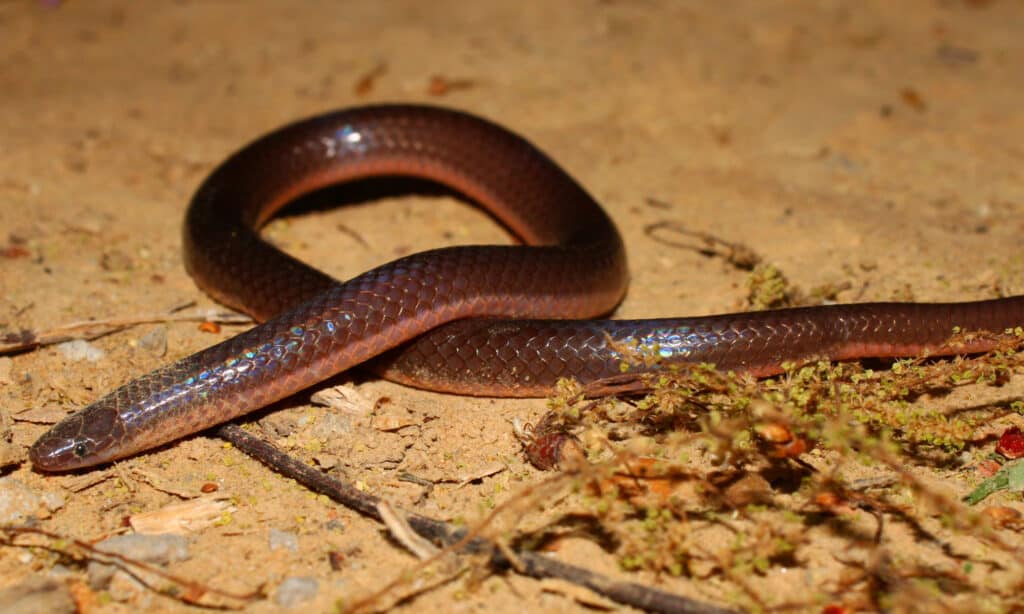
Eastern worm snakes are brown with lustrous scales and range in length from 7 to 11 inches.
©Jason Patrick Ross/Shutterstock.com
A subspecies of the worm snake is the eastern worm snake. Eastern worm snakes are brown with lustrous scales and range in length from 7 to 11 inches. The Piedmont region of South Carolina, Georgia, and New England is home to many of them. They also reside in the highlands and coastal plains. These species are burrowers that favor damp environments. Since they are not poisonous and do not bite, they are harmless to people.
6. Coastal Plain Milk Snake
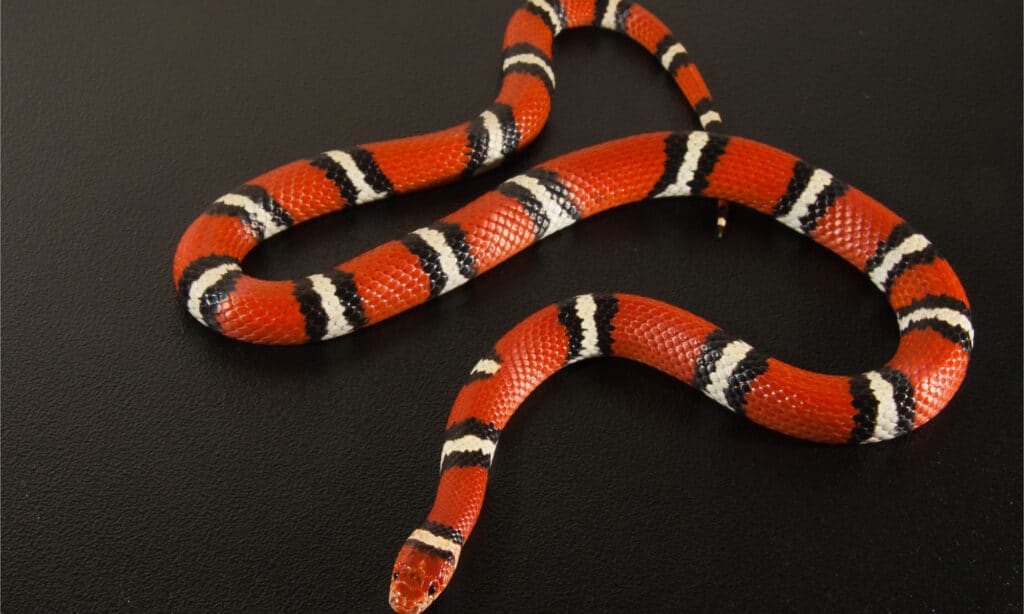
The Coastal Plain milk snake is currently regarded as a hybrid of the scarlet kingsnake and the eastern milk snake.
©Nathan A Shepard/Shutterstock.com
Despite ongoing taxonomic and genetic research, the Coastal Plain milk snake is currently regarded as a hybrid of the scarlet kingsnake and the eastern milk snake. One of the most beautiful snakes in the country, specimens display a wide range of patterns and hues. They are found in environments comparable to the eastern milk snake’s habitat, such as riverbanks, wooded areas, and outbuildings like barns. The greatest known populations of Coastal Plain milk snakes can be found in the Maryland counties of St. Mary’s and Calvert.
7. Rainbow Snake
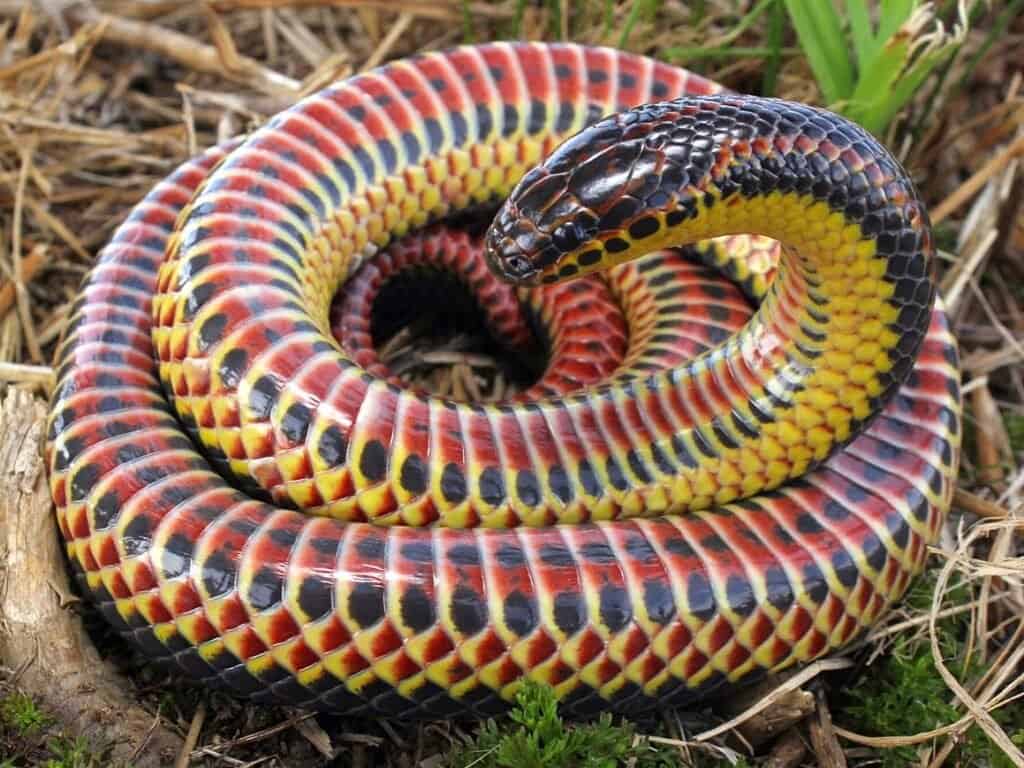
The rainbow snake can be found in the Coastal Plain of the southern United States.
©Charles Baker / CC BY-SA 4.0 – License
Rainbow snakes live in the Coastal Plain of the southern United States, stretching from southern Virginia to eastern Louisiana. In the past, a few rainbow snakes lived in southern Florida, close to Lake Okeechobee. The southern half of the Florida peninsula is currently thought to be snake-free as no snakes have been discovered there in several decades. Rainbow snakes can reach lengths of up to five and a half feet and exist in damp conditions. These snakes used to come in two varieties, but one has since been extinct.
8. Eastern Mud Snake
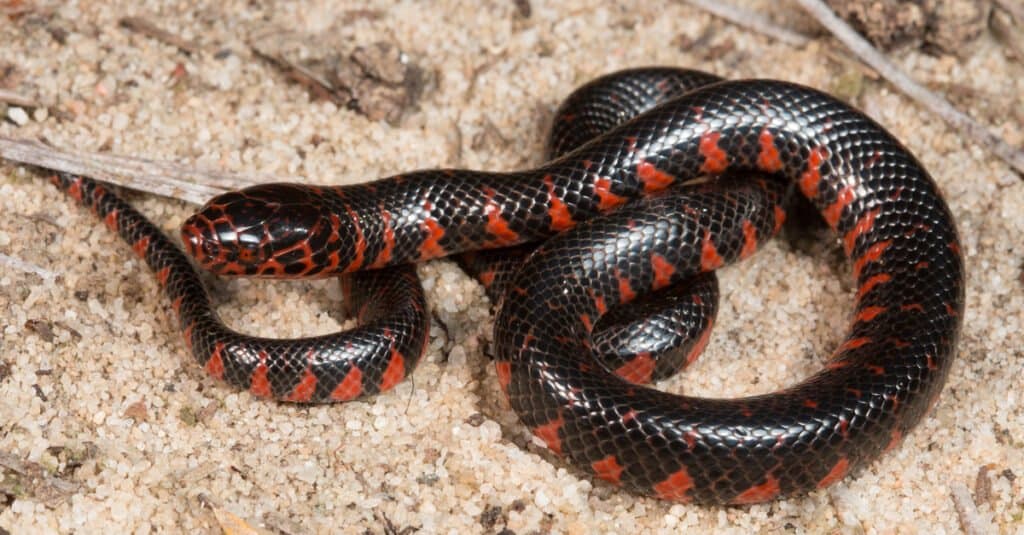
Mud snakes are typically only found in the Coastal Plain of Georgia.
©Nathan A Shepard/Shutterstock.com
From southern Virginia through Florida, the Coastal Plain of the southern United States is home to mud snakes. Mud snakes are typically only found in the Coastal Plain of Georgia, though they occasionally venture into the Piedmont region. In addition to Carolina bays, seasonal wetlands, marshes, cypress swamps, slow-moving streams, and the densely vegetated edges of lakes and ponds, mud snakes can also be found in other types of aquatic habitats. In South Carolina, juvenile mud snakes frequently live in ephemeral wetlands before migrating to more permanent bodies of water as adults.
9. Florida Crowned Snake
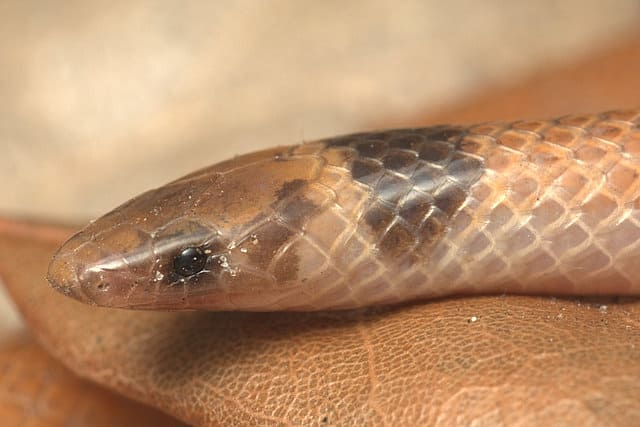
Florida crowned snakes live in sandy habitats, like sand dunes and dry pine flat woods.
©Alessandro Catenazzi / Creative Commons – License
Despite not being present in the Florida Keys or the Panhandle, Florida crowned snakes are native to Florida. With tan bodies, white bellies, and blackheads, Florida crowned snakes resemble rim rock crowned snakes in appearance. However, these sand-loving species choose dry pine flat woods and dunes as habitats. The Florida crowned snake enjoys digging into the loose ground and animal-made burrows and consuming spiders, snails, and worms.
10. Florida Banded Water Snake
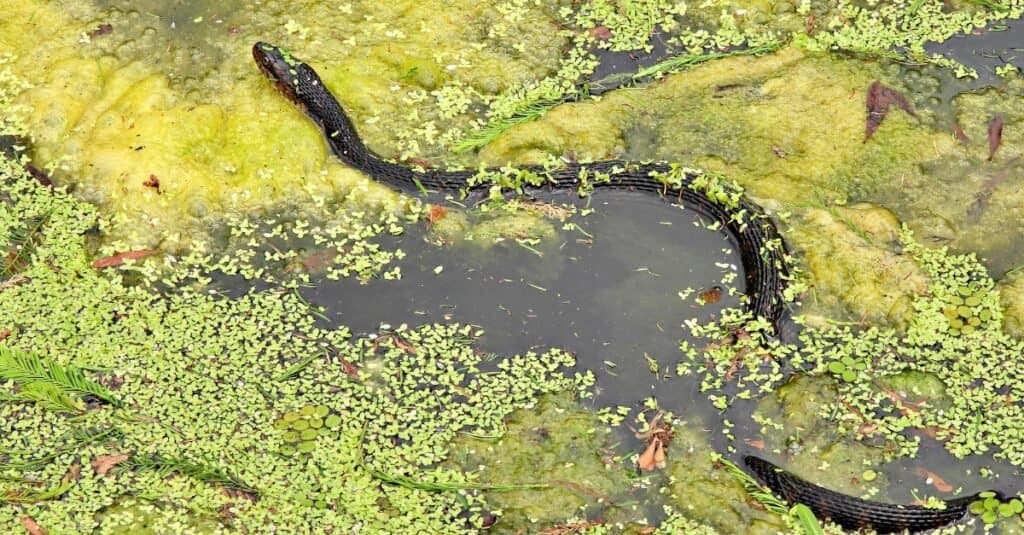
Found in many of the bodies of water in Florida, the Florida-banded water snake consumes everything from frogs to turtles.
©iStock.com/passion4nature
There’s a considerable possibility you’ve encountered either Florida banded water snake if you reside in the Southeast. Nonvenomous Florida-banded water snakes prefer damp areas in the coastal lowlands of Florida, Georgia, South Carolina, and North Carolina. Unfortunately, they are frequently killed in the wild because people mistake them for venomous cottonmouths. Much of the southeastern US is home to the cottonmouth, but it has a much wider inland range.
11. Florida Pine Snake
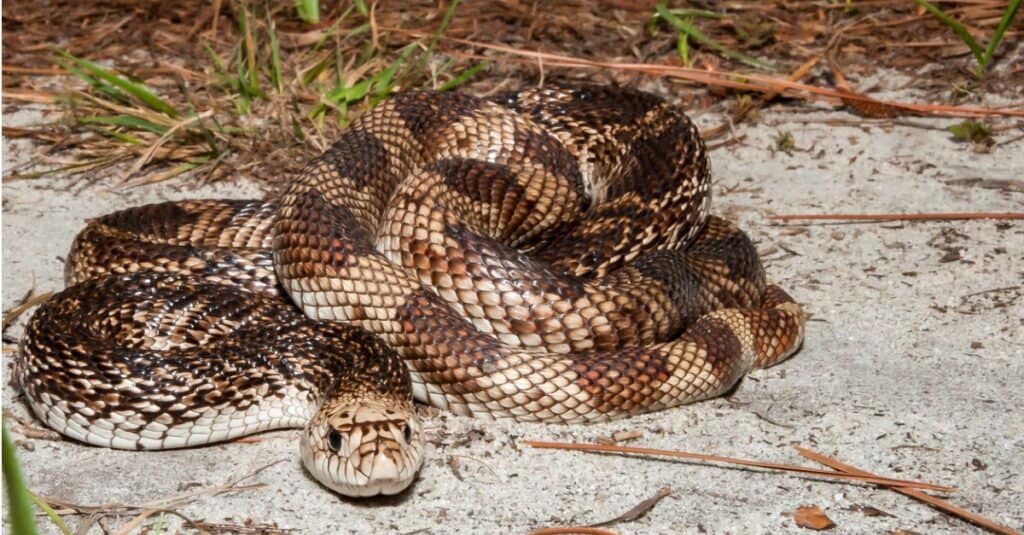
Though non-venomous, the Florida Pine snake squeezes its prey to death.
©iStock.com/JasonOndreicka
The Florida peninsula, southern South Carolina, and central Georgia are all included in the range of the Florida pine snake. These nonvenomous colubrids are native to the southeastern United States and have average lengths of 48 to 90 inches. Despite modest color variations, they are typically gray with dark brown blotches running down their backs—but not on their bellies, which are pure white.
12. Eastern Diamondback Rattlesnake
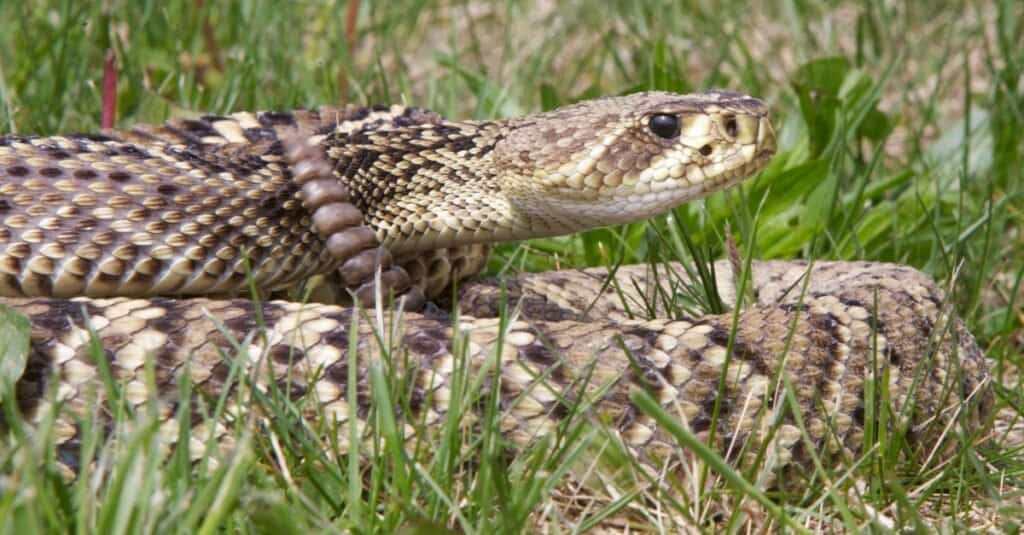
The eastern diamondback rattlesnake can be found in grasslands, longleaf pine flat woods, sandy shorelines, and rolling pine slopes.
©iStock.com/NajaShots
Eastern South Carolina, Southern North Carolina, and all of Florida’s lower coastal regions are home to eastern diamondback rattlesnakes. These snakes can be found in grasslands, longleaf pine flat woods, sandy shorelines, and rolling pine slopes. Large and very dangerous, eastern diamondback rattlesnakes are venomous reptiles. In South Carolina, people hardly see or come into contact with them. It is preferable to keep at least 20 feet away from an eastern diamondback rattlesnake if you spot one. Most eastern diamondback rattlesnake attacks happen when a person steps on or bothers the snake.
13. Eastern Indigo Snake
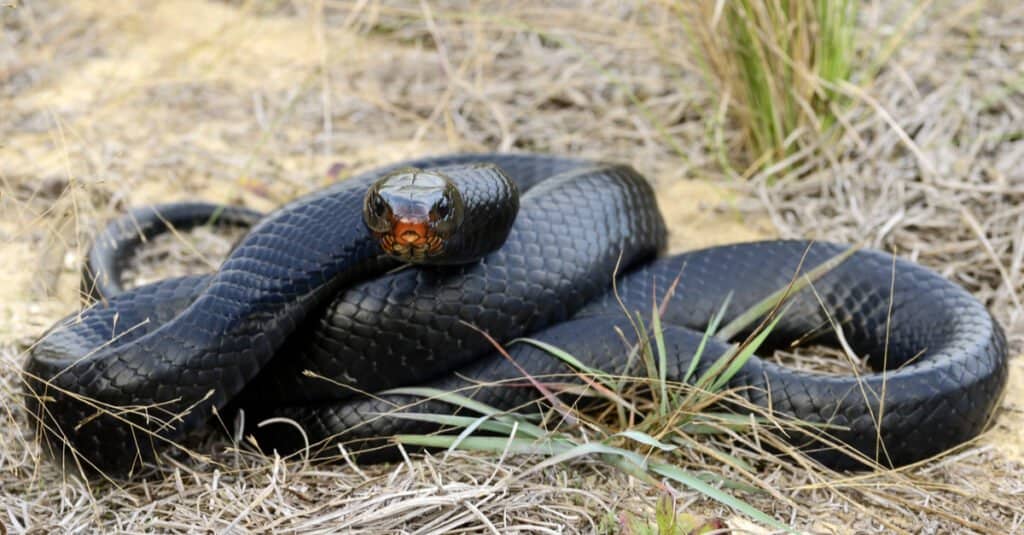
The eastern indigo snake is the longest snake in America.
©Patrick K. Campbell/Shutterstock.com
Although they are frequently kept as pets, eastern indigo snakes are officially threatened in Florida, primarily because of humans. They have almost completely disappeared from the northern parts of Florida because of habitat degradation and fragmentation, among other factors. They are also the largest natural species in North America. Eastern indigo snakes typically weigh between 1.6 and 9.9 pounds (0.72-4.5 kg) and measure 3.6-7.7 feet (1.2-2.36 m) in length.
14. Northern Scarlet Snake
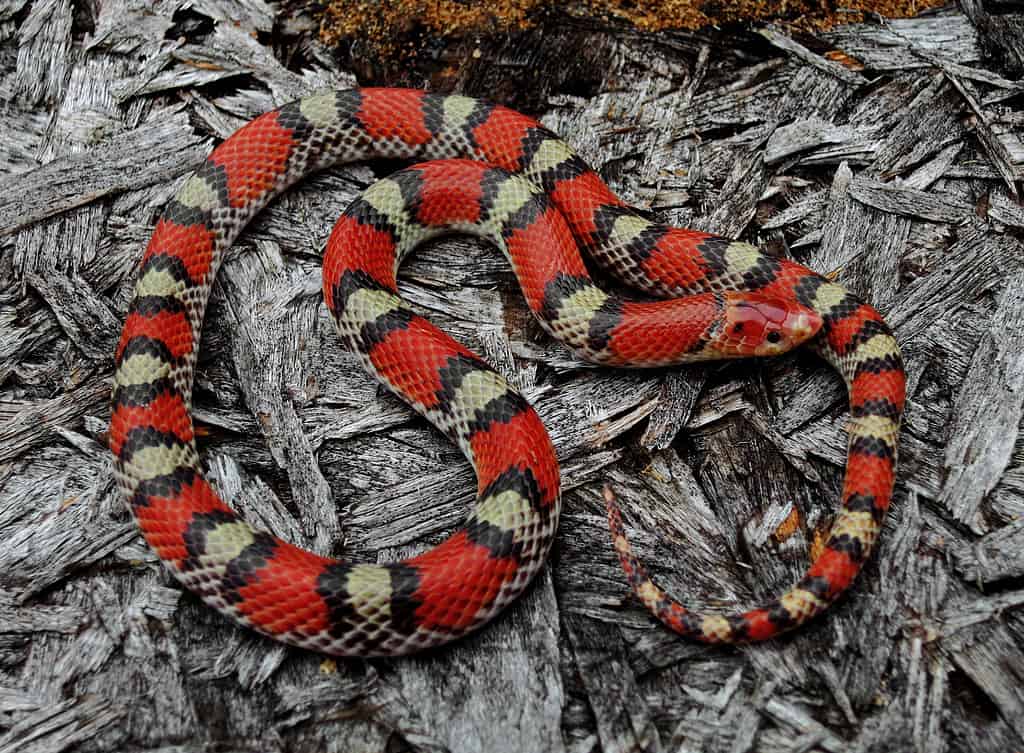
Northern scarlet snakes are skilled borrowers, as they prefer dry, sandy soils and forest settings.
©Peter Paplanus / CC BY 2.0 – License
Northern Scarlet snakes can be found in Florida, the Pine Barrens of New Jersey, the Coastal Plain, and the Piedmont regions of the southeastern United States. These snakes can also be found throughout Georgia, except for the hilly areas of northern Georgia and western South Carolina. Since they prefer dry, sandy soils and forested settings, scarlet snakes are skilled burrowers.
15. Glossy Crayfish Snake
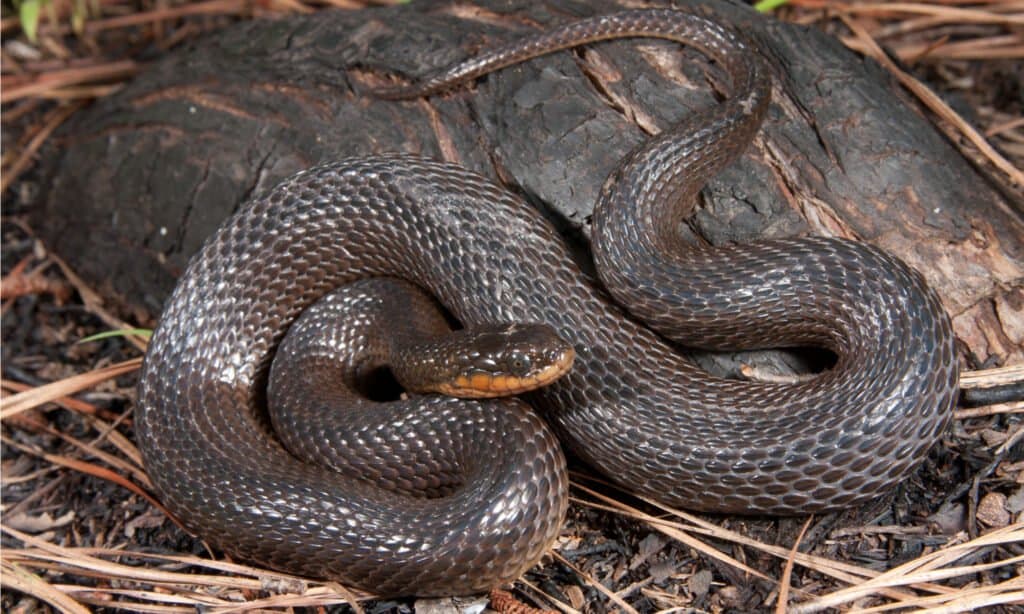
Crayfish snakes have extremely shiny bodies despite having keeled or ridged scales.
©Nathan A Shepard/Shutterstock.com
The Coastal Plain of the southeastern United States, stretching from eastern North Carolina to eastern Texas, is home to the glossy crayfish snake. There is also a small population of this species in eastern Virginia. Marshes, cypress swamps, wetlands, bays, ditches, and ponds or lakes with a lot of vegetation are the habitats of crayfish snakes. Additionally, certain snake species will disperse into new rivers and river systems and relocate into salty water. Crayfish snakes have extremely shiny bodies despite having keeled or ridged scales. As a result, crayfish snakes are occasionally referred to as “glossy swamp snakes.”
How Long Do Snakes Live?
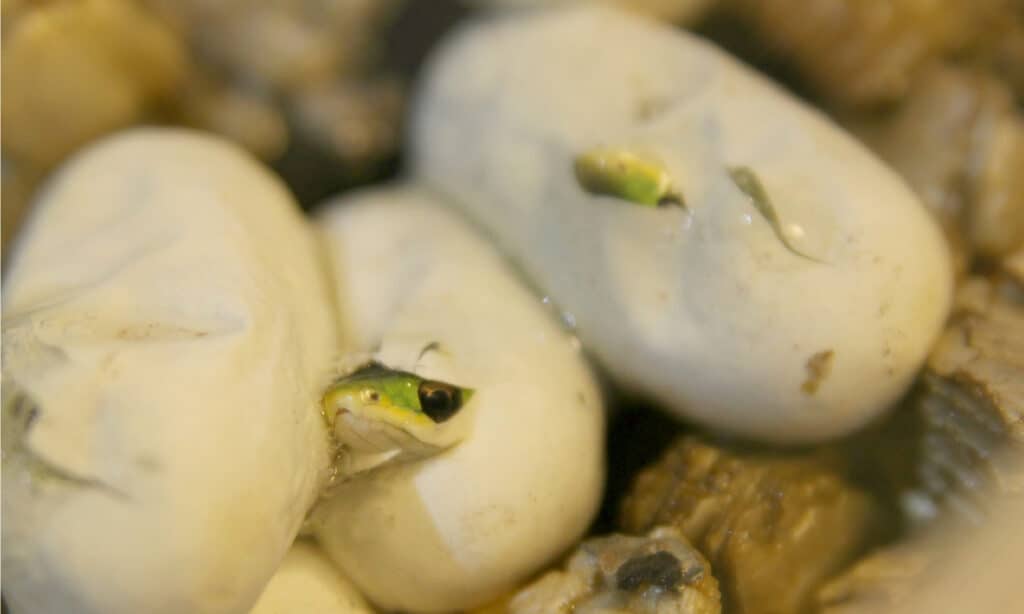
Newly hatched snakes can expect to live 2 – 8 years.
©Stuart Hamilton/Shutterstock.com
It may seem as if snakes live pretty easy lives considering that they are feared predators – but they do face some danger. Eagles, hawks, owls, cats, raccoons, and other carnivores prey on snakes – especially the young. People often kill snakes if they see them – even if they aren’t venomous or if they keep rodents in check. Snakes are run over by cars and their habitats are destroyed by new construction.
If everything goes well for a snake, it can live an average of 2-8 years in the wild. Of course, it can live much longer if there is plenty of prey and no humans nearby. Snakes in captivity who live with no predation can live 15 – 30 years.
Other Types of Snakes That Live in America

California mountain kingsnakes are often mistaken for venomous coral snakes due to their bold colors
©Matt Jeppson/Shutterstock.com
America is home to many species of snakes, some more common than others. Depending on the region, you may find garter and ribbon snakes, which are small and nonvenomous but have brightly colored patterns that can make them difficult to spot in tall grasses. Additionally, Pacific rattlesnakes inhabit deserts and coastal regions, while California mountain kingsnakes are found in mountainous areas throughout the state. Finally, the western hognose snake is also occasionally spotted in parts of Arizona and New Mexico. All of these different types of snakes have adapted to their respective environments over thousands of years and serve important roles within their ecosystems as both predators and prey animals.
Additionally, there have been reports of anacondas living in states along the Gulf Coast—the largest recorded specimen measured over 17 feet long! While sightings are rare, it’s possible that these giant serpents could still inhabit certain wetlands along this part of the continent.
The photo featured at the top of this post is © Dennis W Donohue/Shutterstock.com
Discover the "Monster" Snake 5X Bigger than an Anaconda
Every day A-Z Animals sends out some of the most incredible facts in the world from our free newsletter. Want to discover the 10 most beautiful snakes in the world, a "snake island" where you're never more than 3 feet from danger, or a "monster" snake 5X larger than an anaconda? Then sign up right now and you'll start receiving our daily newsletter absolutely free.
Thank you for reading! Have some feedback for us? Contact the AZ Animals editorial team.






